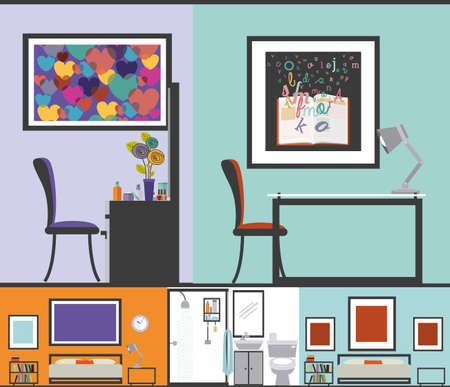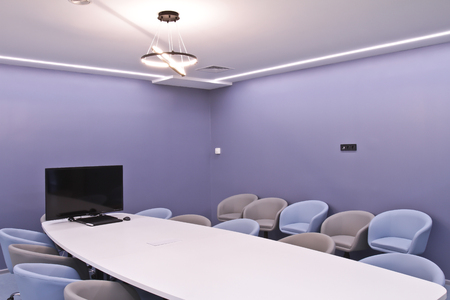Understanding Vastu Principles for Office Spaces
In the vibrant fabric of Indian culture, Vastu Shastra serves as a timeless guide to designing harmonious spaces that uplift both energy and intention. When it comes to a joint family office meeting room, the alignment with Vastu principles becomes even more significant, as it influences not just individual productivity but also collective well-being and prosperity. The core idea behind Vastu is to channel the five natural elements—earth, water, fire, air, and space—in such a way that they foster balance and positive vibrations within the workplace.
According to Vastu Shastra, the direction in which you place furniture, doors, and even seating arrangements can dramatically affect the flow of prana (life energy) throughout the room. In joint family businesses, where decisions are often made collectively and relationships are deeply interconnected, nurturing this energetic harmony is essential. By adhering to foundational Vastu guidelines—like ensuring ample natural light from the east or north and keeping clutter away from entrances—one can create an environment that is conducive for open dialogue, trust, and mutual respect among all family members involved in business affairs.
Discovering these principles empowers families to consciously design their meeting rooms not just for aesthetics or convenience, but also for fostering unity and shared success. By integrating age-old wisdom with modern needs, your joint family office meeting room can become a sanctuary of collaboration, positivity, and holistic growth.
Ideal Seating Directions and Positions
According to Vastu Shastra, the arrangement of seating in a joint family office meeting room plays a vital role in ensuring harmonious discussions and collective growth. Selecting the correct directions for seating not only promotes clarity in communication but also helps maintain unity among family members. In Indian tradition, respecting each persons position in the family hierarchy is essential, and Vastu supports this through specific placements.
Auspicious Directions for Seating
Vastu recommends that the head of the family or the most senior member should sit facing either the East or North direction. These directions are associated with prosperity, wisdom, and positive energy flow. Other family members can be seated as per their roles and responsibilities, ensuring everyone faces favourable directions. Avoid seating anyone with their back to the entrance, as this can block opportunities and create misunderstandings.
Seating Arrangement Table as per Vastu
| Family Member | Recommended Facing Direction | Significance |
|---|---|---|
| Head of Family (Elder/Decision Maker) | East/North | Leadership, Wisdom, Growth |
| Younger Members/Assistants | North-East/North-West | Supportive Roles, New Ideas |
| Finance/Accounts Responsible | North/West | Financial Stability, Clarity |
| Guests/External Consultants | South-East/East | Openness to New Perspectives |
Cultural Note:
In many Indian joint families, it is customary to acknowledge elders by offering them central or prominent seats during meetings. This gesture reflects respect and ensures decision-making flows smoothly from experience to action. By aligning these traditions with Vastu guidelines, families can create a balanced atmosphere where every voice is heard and valued.

3. Role-Based Seating As Per Vastu
In a joint family office meeting room, aligning seat allocation with traditional family hierarchies is essential for maintaining harmony and mutual respect. According to Vastu Shastra, the placement of seats should reflect each members role and responsibility within the family business. Senior members or elders, often seen as the guiding force, are ideally seated in the south or west direction facing north or east—positions believed to enhance authority and clarity in decision-making. This arrangement not only honours their wisdom but also encourages younger members to show respect and learn from their experience.
Assigning seats according to roles ensures that every member feels valued and acknowledged for their contribution. For example, those handling financial matters can be seated towards the north, known as the direction of wealth in Vastu, while creative or operational team members may be placed towards the east, fostering new ideas and growth. By consciously setting up these seating patterns, joint families can create an environment where responsibilities are clear, discussions are harmonious, and decisions are made collectively yet efficiently.
This thoughtful approach fosters not only effective communication but also strengthens the bonds within the family structure. When everyone’s position in the room reflects their responsibilities and seniority, it becomes easier to uphold discipline, maintain decorum during meetings, and ensure that every voice is heard at the right moment. Ultimately, Vastu-inspired seating arrangements go beyond aesthetics—they cultivate a positive energy flow that supports collective prosperity and unity in a joint family enterprise.
4. Colour and Décor Selection in Meeting Room
Choosing the right colours and décor for a joint family office meeting room is vital as per Vastu Shastra, especially in an Indian context where aesthetics deeply influence mood and energy. Implementing Vastu-compliant colours and décor not only enhances positivity but also supports teamwork and concentration during important discussions.
Vastu-Recommended Colours for Meeting Rooms
| Colour | Vastu Significance | Indian Context Application |
|---|---|---|
| Light Yellow | Promotes clarity, communication, and optimism | Reflects warmth and auspiciousness, ideal for fostering unity |
| Off-White/Cream | Brings calmness and purity to the environment | Traditional choice that suits all generations in a joint family |
| Light Green | Enhances harmony, growth, and balance | Symbolic of renewal and collective progress in Indian culture |
| Pale Blue | Aids focus and peace of mind | Culturally resonates with serenity and open dialogue |
Décor Elements Resonating with Indian Aesthetics
- Artworks: Choose framed traditional Indian paintings or subtle motifs such as Madhubani or Warli art to infuse heritage without distraction.
- Plants: Place indoor plants like Tulsi or bamboo on side tables to purify the air and bring natural balance.
- Sacred Symbols: Incorporate discreet motifs of Om, Swastik, or lotus—symbols of prosperity and positive energy—but avoid placing them directly behind seats.
- Aromatic Elements: Use mild incense or essential oil diffusers with sandalwood or jasmine fragrances to maintain freshness and tranquillity.
- Curtains & Fabrics: Opt for cotton or linen drapes in soft hues with minimalistic ethnic patterns to keep the ambience light yet rooted in culture.
The Influence of Colour & Décor on Teamwork and Focus
A harmonious combination of Vastu-approved colours and meaningful décor aligns energies within the meeting room. This not only uplifts mood but also encourages active participation from all family members across generations. When the physical space is thoughtfully designed, it naturally nurtures respectful discussions, strengthens collaboration, and ensures every voice is heard—true to both Vastu principles and Indian joint family values.
5. Incorporating Sacred Symbols and Plants
In the context of a joint family office meeting room, infusing the space with sacred symbols and indoor plants as per Vastu Shastra can harmonise energies and foster holistic well-being for all family members. Integrating auspicious symbols such as the Swastik, Om, or Shree Yantra on the north or east walls not only invokes divine blessings but also promotes a positive and collaborative atmosphere during meetings. These symbols are revered in Indian culture for their ability to dispel negativity and attract prosperity.
Choosing Vastu-Appropriate Indoor Plants
Selecting the right plants is equally important in creating a vibrant and healthy environment. Tulsi (Holy Basil), money plant, and bamboo are highly recommended in Vastu for their purifying qualities. Placing them in the north-east or east corner of the meeting room can enhance mental clarity and encourage open-hearted discussions among family members.
Cultural Significance of Sacred Elements
Displaying small brass idols of Ganesha or Saraswati near the entrance or on a dedicated shelf can help to remove obstacles and inspire wisdom. Always keep these sacred objects clean and respected, as they represent more than mere decoration—they embody tradition, protection, and spiritual guidance.
Holistic Benefits for Joint Family Harmony
By thoughtfully incorporating Vastu-compliant symbols and greenery, you not only beautify your family office meeting room but also cultivate an ambiance where every member feels valued, peaceful, and motivated. This mindful approach ensures that collective decisions are made with clarity, unity, and the blessings of higher energies.
6. Maintaining Clutter-Free and Energised Ambience
In a joint family office meeting room, maintaining an organised and vibrantly energised space is crucial for fostering harmony and productivity as per Vastu Shastra. A clutter-free environment not only supports clear thinking but also helps in attracting positive energies that are essential for collective growth and successful outcomes. Here are some practical Vastu-based tips to keep your meeting room in perfect balance:
Declutter Regularly for Positive Flow
Ensure that the meeting room is free from unnecessary papers, files, and objects. According to Vastu, clutter blocks the flow of prana (energy) and can create confusion or disagreements within the team. Assign a weekly schedule for tidying up the space, and encourage every family member involved to keep their work areas neat.
Proper Storage Solutions
Use closed cabinets or shelves preferably placed on the south or west wall to store documents and stationery. Avoid stacking items on tables or in corners, as this hampers the natural movement of energy in the room. Label storage clearly to promote efficiency and reduce time spent searching for materials during important discussions.
Infuse Vibrant Energy with Natural Elements
Introduce indoor plants like money plant or bamboo, which are auspicious in Indian culture and help purify the air while enhancing positivity. Position them towards the north or east side of the meeting room for optimal benefits. Ensure these plants are well-maintained as withered leaves can attract stagnation according to Vastu principles.
Aromatic and Visual Upliftment
Light a diya (oil lamp) or use gentle incense sticks before meetings to clear negativity and welcome auspicious vibrations. Adorn walls with soothing artwork or spiritual symbols such as Om or Swastik, which resonate with Indian sensibilities and reinforce unity among family members.
Mindful Use of Colours and Lighting
Select light shades like off-white, cream, or light yellow for walls, as these colours are known to amplify mental clarity and peace according to Vastu. Ensure ample natural sunlight enters the room; if not possible, install soft white LED lights to mimic daylight, keeping the atmosphere lively yet calm.
Encourage Collective Responsibility
Create a simple rota where each family member takes turns in ensuring the meeting room remains clean and energised. This practice not only reinforces teamwork but also invokes a shared sense of ownership—key to any successful joint family endeavour.
By integrating these practical Vastu tips into your joint family office meeting room, you will nurture a harmonious setting where ideas flourish, decisions are made with clarity, and every member feels respected and energised—aligning perfectly with Indian values of togetherness and mutual growth.

